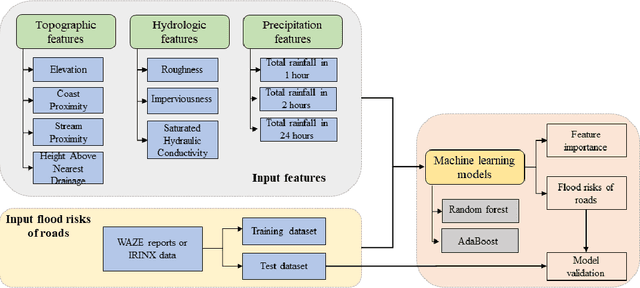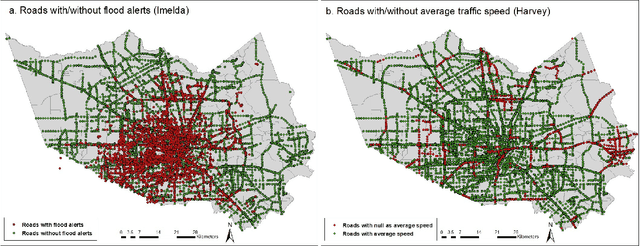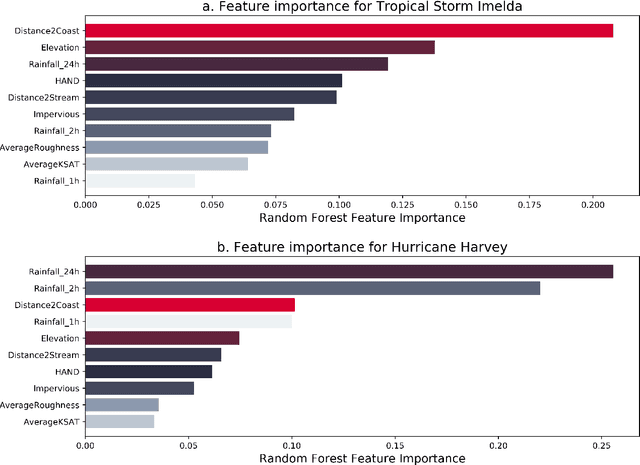Faxi Yuan
Predicting Road Flooding Risk with Machine Learning Approaches Using Crowdsourced Reports and Fine-grained Traffic Data
Aug 30, 2021



Abstract:The objective of this study is to predict road flooding risks based on topographic, hydrologic, and temporal precipitation features using machine learning models. Predictive flood monitoring of road network flooding status plays an essential role in community hazard mitigation, preparedness, and response activities. Existing studies related to the estimation of road inundations either lack observed road inundation data for model validations or focus mainly on road inundation exposure assessment based on flood maps. This study addresses this limitation by using crowdsourced and fine-grained traffic data as an indicator of road inundation, and topographic, hydrologic, and temporal precipitation features as predictor variables. Two tree-based machine learning models (random forest and AdaBoost) were then tested and trained for predicting road inundations in the contexts of 2017 Hurricane Harvey and 2019 Tropical Storm Imelda in Harris County, Texas. The findings from Hurricane Harvey indicate that precipitation is the most important feature for predicting road inundation susceptibility, and that topographic features are more essential than hydrologic features for predicting road inundations in both storm cases. The random forest and AdaBoost models had relatively high AUC scores (0.860 and 0.810 for Harvey respectively and 0.790 and 0.720 for Imelda respectively) with the random forest model performing better in both cases. The random forest model showed stable performance for Harvey, while varying significantly for Imelda. This study advances the emerging field of smart flood resilience in terms of predictive flood risk mapping at the road level. For example, such models could help impacted communities and emergency management agencies develop better preparedness and response strategies with improved situational awareness of road inundation likelihood as an extreme weather event unfolds.
Spatio-Temporal Graph Convolutional Networks for Road Network Inundation Status Prediction during Urban Flooding
Apr 06, 2021



Abstract:The objective of this study is to predict the near-future flooding status of road segments based on their own and adjacent road segments current status through the use of deep learning framework on fine-grained traffic data. Predictive flood monitoring for situational awareness of road network status plays a critical role to support crisis response activities such as evaluation of the loss of access to hospitals and shelters. Existing studies related to near-future prediction of road network flooding status at road segment level are missing. Using fine-grained traffic speed data related to road sections, this study designed and implemented three spatio-temporal graph convolutional network (STGCN) models to predict road network status during flood events at the road segment level in the context of the 2017 Hurricane Harvey in Harris County (Texas, USA). Model 1 consists of two spatio-temporal blocks considering the adjacency and distance between road segments, while Model 2 contains an additional elevation block to account for elevation difference between road segments. Model 3 includes three blocks for considering the adjacency and the product of distance and elevation difference between road segments. The analysis tested the STGCN models and evaluated their prediction performance. Our results indicated that Model 1 and Model 2 have reliable and accurate performance for predicting road network flooding status in near future (e.g., 2-4 hours) with model precision and recall values larger than 98% and 96%, respectively. With reliable road network status predictions in floods, the proposed model can benefit affected communities to avoid flooded roads and the emergency management agencies to implement evacuation and relief resource delivery plans.
 Add to Chrome
Add to Chrome Add to Firefox
Add to Firefox Add to Edge
Add to Edge